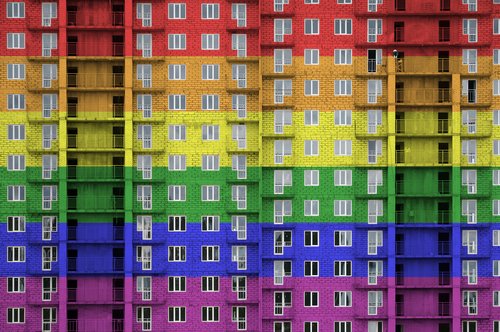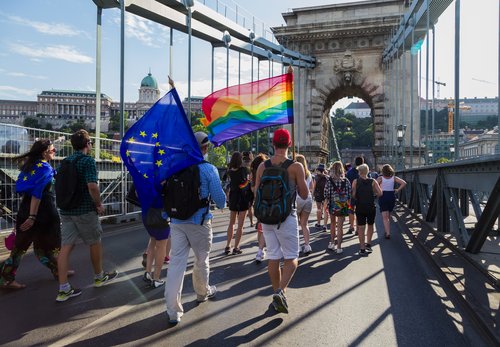ECMI Minorities Blog. Unable to Stay, Nowhere to Go: The Hidden Reality of LGBTIQ Homelessness in the European Union


Author: Clara Lhullier
June Pride Month has been one of most celebrated dates worldwide over the past years. From 1969 onwards, LGBTIQ minorities have taken over the streets across the world to make their voices and claims heard, and to fight for full equality. Clearly, many achievements have been made since the Stonewall Inn demonstrations erupted in New York and gave birth to this yearly celebration. However, countries still vary widely in terms of protecting LGBTIQ communities: while in many parts of the world, pride events are still banned and demonstrators are persecuted, the European Union is widely known for its increasing efforts to safeguard these minorities in its provisions.
Despite this, a more careful look still reveals important gaps when it comes to minorities’ rights on the grounds of their sexual orientation, gender identity and expression, and sex characteristics (SOGIESC). Some of the most debated issues include EU member states’ varying regulations concerning LGBTIQ rights such as same-gender marriages, as well as the rights of rainbow families across countries. Indeed, according to Rainbow Europe, marriage equality is only recognized in 13 member states, while the same number applies to joint adoption. Recognition of trans parenthood is only present in four EU countries – Belgium, Malta, Slovenia and Sweden – while the same number applies for member states who have gender-recognition procedures without medical requirements. These are Denmark, Ireland, Luxembourg and Malta.
To make matters worse, in the past year ILGA-Europe has noted a concerning standstill with regards to advances in LGBTIQ rights. This was not solely due to the Covid-19 pandemic: rather, it stems from backlashes in the political environment of the European Union. The 2021 Annual Review of Rainbow Europe has reported a sharp rise in abuse and hate speech against LGBTIQ people, and a significant growth of opposition towards trans rights across Europe. In a report recently released, the European Union Agency for Fundamental Rights (FRA) estimated that two in five LGBTIQ minorities experienced harassment due to their SOGIESC in 2019. Rates were the highest for trans (48%) and intersex (42%), frequently the most vulnerable and discriminated against. It also reported a worsening environment for civil society organizations and activists promoting human rights and non-discrimination.
While there is a great awareness of some vulnerabilities faced by LGBTIQ communities, other issues rarely make the headlines and remain almost invisible to most of us: this is the case of LGBTIQ minorities who experience homelessness. Particularly vulnerable are the youth and those living in member states where these minorities’ rights are not yet fully guaranteed by law. Indeed, in 2020 FRA estimated that one in five LGBTIQ individuals experience homelessness, rising to one in three for trans people and nearly 40% for intersex people. Despite being at heightened risk, most of the times homelessness service providers lack the skills, training and competencies to adequately help LGBTIQ groups who look for safe spaces.
In what might be the only available study on this issue so far, the European Federation of National Organisations Working with the Homeless (FEANTSA) and True Colors United have conducted a survey of 64 European homelessness organizations, of which only eight reported providing specialized services for LGBTIQ youth, and five for trans youth. However, over 60% have previously dealt with young LGBTIQ experiencing homelessness, without any training or governmental support. As noted by Jama Shelton of True Colors United, this may leave already vulnerable LGBTIQ youth at risk of being re-marginalized and exposed to a cycle of homelessness and other traumas.
Over the past years, FEANTSA has consistently outlined the absence of qualitative and quantitative data mapping of LGBTIQ people who utilize available service. The lack of data leads to poor understanding of the LGBTIQ homelessness drivers and impedes activist organisations’ efforts to build safe and welcoming spaces for those who arrive. To emphasise this, Robbie Stakelum of FEANTSA urges homelessness services along with LGBTIQ organizations to work together and develop a common policy that addresses specific demands of these minority groups.
On the other side of the spectrum, while conducting a survey of 71 LGBTIQ organizations in Europe, ILGA and True Colors United showed that 90% of them reported the absence of institutional policies specifically tackling LGBTIQ youth homelessness or were unsure if they existed in their countries. Over half of those surveyed spoke of a lack of governmental support to address this issue. This may indicate that LGBTIQ homelessness remains excluded from public policy, despite the European Union’s efforts to protect minorities taking into account their SOGIESC.
Clearly, LGBTIQ youth who undergo homelessness are also heterogenous and often belong to more than one minority group. This is especially the case for racial, ethnic and religious minorities as well as LGBTIQ asylum seekers, already discriminated on the grounds of their cultural, ethnic and religious identity. As posed by the European Commission, an intersectional approach is needed to understand additional barriers they encounter. This does not only hold true in the case of homelessness, but also when it comes to structural inequalities such as finding employment, housing and stable income sources. Trans people are particularly vulnerable: despite EU’s Employment Equality Directive, FRA reports that one third of trans job seekers still encounter discrimination, and that the rate of trans people in paid employment is only 51% compared to 61% of the general population. Employment data is still missing for intersex people, as well as for LGBTIQ asylum seekers.
This overview does not only how specific challenges faced by the most vulnerable LGBTIQ minorities, but might also indicate societal marginalization and stigmatization as important predictors for a heightened risk of exclusion and homelessness. This is of a particular concern in member states where there has been a rising wave of LGBTIQ-phobia and where comprehensive anti-discrimination legislation that deals directly with SOGIESC is still absent.
Of all the member states, Poland emerges as the most hostile country for sexual minorities, having scored the lowest regarding LGBTIQ equality laws and policies according to Rainbow Europe 2021 report. This is not by chance: during recent years, the Law and Justice Party (PiS) has strengthened ties with the Roman Catholic church and gained increased popularity building on a populist rhetoric that scapegoats LGBTIQ minorities. Often in agreement with other Visegrad Four members, measures implemented by PiS have caused increased concern in the European Union. These include the so-called ‘LGBT Ideology Free Zones’ anti-gay resolutions passed in over a third of the Polish territory, growing LGBTIQ-phobic intimidation during public events and Pride marches, and persecution of activists speaking out about LGBTIQ rights. Backlashes against the trans community in Hungary have also been of concern.
The Centre for Research on Prejudice of the University of Warsaw reported that hate speech is particularly prominent among Polish youth: more than 40% of young people said they used it against gay people and refugees. In an environment where existing is already an act of subversion, many young LGBTIQ have remained without any alternatives other than leaving their homes and looking for safe spaces elsewhere. For those in the LGBTIQ Free Zones, crackdowns against supporting organizations make finding shelters an especially difficult task, which heightens their vulnerability to homelessness in an already unsafe environment. Indeed, for Anna Maria Żukowska, Vice-chair of the Group for LGBTIQ Equality, ensuring their safety and preventing the risk of suicide has become the one of most important orientations of NGOs in Poland.
State emergency measures following the outbreak of Covid-19 have only exacerbated growing hostility towards these minority groups. Not only has there been a sharp increase of domestic violence, which strongly resonates within LGBTIQ-phobic families, but the decrease in job opportunities and income sources have left many unable to make ends meet and more susceptible to homelessness. As reported by Transgender Europe and Human Rights Watch, this was especially the case of trans sex workers and LGBTIQ asylum seekers, whose jobs were not included in the government’s relief packages.
Only recently, the European Commission released its first-ever LGBTIQ Equality Strategy, drawing from four pillars: tackling discrimination, ensuring safety, building LGBTIQ inclusive societies and leading the call for LGBTIQ equality around the world. Along with declaring the European Union a LGBTIQ Freedom Zone, it urges EU members to adopt the strategy’s provisions within their own national legal framework. While this might be the first initiative that directly looks at LGBTIQ youth homelessness, it was already met with resistance in Poland and Hungary, where gender is perceived as an ideology. It is still uncertain how these proposals will unfold, let alone be incorporated uniformly by all EU members.
In this scenario, a European commitment to specifically tackle LGBTIQ vulnerabilities is more urgent than ever. Member states should work together in gathering data and building public policies that properly address these minorities’ needs. Accordingly, bottom-up efforts between relevant organizations and homeless shelters should be made to support LGBTIQ youth. Although the European Commission has recently shown positive improvement in this direction, they still have a long way to go. Overcoming internal clashes to build a union where minorities are neither afraid of expressing their identity nor discriminated against would be the first step towards full equality.

Commentaries
If you wish to write a commentary on this blog post, please contact the ECMI Minorities Blog editor Dr. Marika Djolai.

